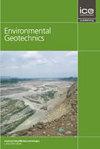片岩取向对云母片岩破坏模式及间接抗拉强度的影响
IF 2.2
4区 工程技术
Q3 ENGINEERING, GEOLOGICAL
引用次数: 0
摘要
间接拉伸试验是岩石表征的重要室内试验方法。岩石组构(如片岩)的存在使测试结果的评估复杂化。对云母片岩试样进行了145次间接拉伸试验,研究片岩取向对破坏模式和抗拉强度的影响。抗拉强度结果没有提供片理取向与抗拉强度之间的明确关系,因此对破坏模式进行了研究。结合试样表面和边缘观察到的断裂模式,开发了一种新的破坏模式命名方案。单模破坏组试件在两个面均出现一种破坏模式,即轴向破坏(73例)、片理破坏(6例)或面外破坏(7例)。混合模式破坏组有32个试样,在一个面呈现一种破坏模式,在另一个面呈现另一种破坏模式。混合模式破坏组27个试件,试件两面均有多种破坏模式。结果表明,含轴向破坏成分的混合模态和混合模态试件的间接抗拉强度高于不含轴向破坏成分的试件。使用Levene 's等方差检验和双样本t检验对抗拉强度数据进行统计分析,混合模式和混合模式失效组之间无统计学差异。单模态轴向破坏试件的抗拉强度与混合模态和混合模态组合破坏试件的抗拉强度有统计学差异。这些结果清楚地强调了间接抗拉强度应该用片理取向和破坏模式来评估。本文章由计算机程序翻译,如有差异,请以英文原文为准。
Influence of Schistosity Orientation on Failure Mode and Indirect Tensile Strength of Mica Schist
The indirect tension test is an important laboratory test for rock characterization. The presence of rock fabric, such as schistosity, complicates the assessment of test results. One hundred and forty-five indirect tension tests were conducted on mica schist specimens to investigate the effect of schistosity orientation on failure mode and tensile strength. Tensile strength results did not provide a clear relationship between schistosity orientation and tensile strength, so the failure patterns were investigated. A new naming scheme for failure modes was developed, incorporating fracture patterns observed in the specimen faces and edges. The Single Mode failure group specimens had only one failure pattern that appeared on both specimen faces, either axial failure (seventy-three specimens), schistosity failure (six specimens), or out-of-plane failure (seven specimens). The Mixed Mode failure group had thirty-two specimens that exhibited one failure pattern on one face and another on the other. The Hybrid Mode failure group had twenty-seven specimens with multiple failure patterns on both specimen faces. It was noted that Mixed Mode and Hybrid Mode specimens with components of axial failure had higher indirect tensile strengths than specimens without elements of axial failures. Statistical analyses of the tensile strength data using Levene’s Test for equal variances and two-sample t-tests showed no statistical difference between the Mixed Mode and Hybrid Mode failure groups. However, there was a statistical difference between the tensile strengths of the Single Mode axial failure specimens and the combined Mixed Mode and Hybrid Mode failure groups. These results clearly emphasize that indirect tensile strength should be assessed using schistosity orientation and failure mode.
求助全文
通过发布文献求助,成功后即可免费获取论文全文。
去求助
来源期刊

Environmental geotechnics
Environmental Science-Water Science and Technology
CiteScore
6.20
自引率
18.20%
发文量
53
期刊介绍:
In 21st century living, engineers and researchers need to deal with growing problems related to climate change, oil and water storage, handling, storage and disposal of toxic and hazardous wastes, remediation of contaminated sites, sustainable development and energy derived from the ground.
Environmental Geotechnics aims to disseminate knowledge and provides a fresh perspective regarding the basic concepts, theory, techniques and field applicability of innovative testing and analysis methodologies and engineering practices in geoenvironmental engineering.
The journal''s Editor in Chief is a Member of the Committee on Publication Ethics.
All relevant papers are carefully considered, vetted by a distinguished team of international experts and rapidly published. Full research papers, short communications and comprehensive review articles are published under the following broad subject categories:
geochemistry and geohydrology,
soil and rock physics, biological processes in soil, soil-atmosphere interaction,
electrical, electromagnetic and thermal characteristics of porous media,
waste management, utilization of wastes, multiphase science, landslide wasting,
soil and water conservation,
sensor development and applications,
the impact of climatic changes on geoenvironmental, geothermal/ground-source energy, carbon sequestration, oil and gas extraction techniques,
uncertainty, reliability and risk, monitoring and forensic geotechnics.
 求助内容:
求助内容: 应助结果提醒方式:
应助结果提醒方式:


